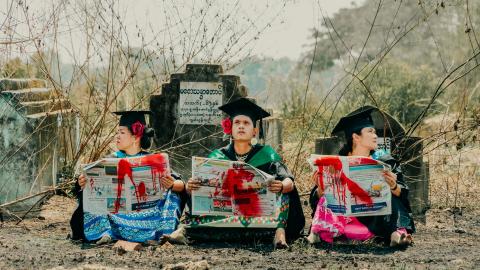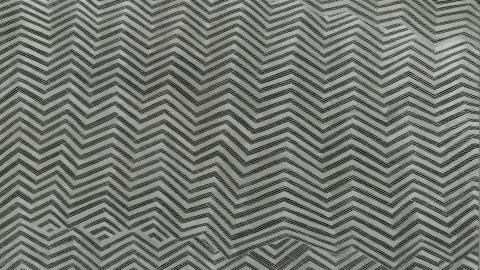ESSAY: Navigating new futures
By Tarun Nagesh, Reuben Keehan, Ruth McDougall
Artlines | 4-2021 |
QAGOMA’s landmark exhibition series, the Asia Pacific Triennial of Contemporary Art (APT), celebrates its tenth iteration in 2021. APT10 brings together more than 150 artists, collectives and filmmakers to reflect on complex histories, current urgencies and cultural encounters as they imagine a multiplicity of futures, write Tarun Nagesh, Reuben Keehan and Ruth McDougall.

For almost three decades, the Asia Pacific Triennial of Contemporary Art (APT) has focused on the art of one of the most socially and culturally diverse regions of the world. Throughout this geographic expanse, the contexts in which art practices emerge are constantly changing in tandem with social and political conditions. Currently, this change is happening with unprecedented speed and dynamism. The tenth edition of APT looks towards the future of art and the contemporary conditions we face in the world together. The exhibition reveals artists rethinking relationships locally and globally, reimagining cultural knowledge and practices to fluidly meet evolving circumstances, and giving vision to new worlds and futures in the face of fragility and uncertainty.
Within its broader contingent of 69 projects by some 150 artists, APT10 features four co-curated sections that draw together multiple practitioners. These encompass indigenous futurisms from Taiwan; the story songs of the Uramat people of East New Britain; historical and contemporary exchanges between Yolngu and Macassan communities in north-east Arnhem Land and southern Sulawesi; and a celebration of the strength and diversity of artistic expression in the islands and atolls of northern Oceania. The Australian Centre of Asian and Pacific Art (ACAPA), the triennial’s research arm, provides the framework for initiatives that further broaden the community involved in the APT in focused and meaningful ways. The ACAPA Pacifika Community Engagement Project, co-created with a group of ten dynamic local representatives, specifically platforms the knowledge and values of Pacific communities in south-east Queensland. In addition, APT10 has played host to the inaugural Creative New Zealand Pacific Curator Residency (Australia) with Auckland-based artist and curator Natasha Matila-Smith, and also includes learning initiatives driven by artist-in-residence Brian Fuata.

Brian Fuata / Performance documentation during The 10th Asia Pacific Triennial of Contemporary Art (APT10) Media Preview at GOMA (featuring a window installation by Shannon Novak in the background), November 2021 / © The artists / Photograph: C Callistemon, QAGOMA
Presented throughout the entirety of GOMA and the central spaces of QAG, APT10 is staged with an ambition of scale and richness of materiality, while continuing to explore ideas around what constitutes contemporary art in the region. The vast majority of its latest edition consists of new works and — while the exhibition doesn’t seek to explore a singular thematic premise — commonalities and dialogues begin to manifest as artists represent their ideas and cultures and respond to their contemporary situations.
The future is now a more urgent subject than ever; in response, artists in APT10 position future thinking around diverse voices and possibilities. Critical to new perspectives are artists examining their cultural knowledge, practices and histories for current and emerging generations. An epically-scaled painting from Waanyi artist Gordon Hookey’s ‘MURRILAND!’ series will be shown for the first time in APT10. It paints a broad story of Australia’s creation and history on the lands in and around where APT10 takes place, raising questions of how, who and for what purpose such histories were written. Other questions of our perception of history manifest in Lee Paje’s re-visioning of creation stories across a series of interlinked oil paintings on copper, where gender and race are no longer the frames used to understand history and identity. Also drawing on stories of creation are indigenous Warli brothers Mayur and Tushar Vayeda, from the village of Ganjad, India, who apply the distinct techniques of Warli painting to illustrate their creation story at a scale and level of detail unprecedented in the centuries-old tradition of Warli painting, across a series of paintings more than 30 metres in length.

Lee Paje / The Philippines b.1980 / Somewhere, someday when we are the sea (detail) 2021, installed for APT10, GOMA, November 2021 / Oil on copper / Purchased 2021 with funds from Tim Fairfax AC through the Queensland Art Gallery | Gallery of Modern Art Foundation / © Lee Paje / Photograph: M Campbell, QAGOMA
These rewritings are also central to ideas of indigenous futurism as artists draw on materials, techniques and knowledge for new social conditions and broad audiences, conjuring ways in which cultures carry agency ahead. In a cinematic science-fiction inspired video filmed at the foothills of the Himalayas in Nepal, Subash Thebe Limbu, for example, has developed his work around imagining a future that gives indigenous people ‘agency to imagine and carry out thought experiments and see themselves in the future practising Indigenous knowledge, ideas along with science and technology’.1 The sentiment similarly resonates with the ‘indigenous punk’ contributions of Amis choreographer Fangas Nayaw. While noting that time is not linear, but rather composed of multiple concentric circles, Nayaw proposes a ‘code of action’ based on the condition that the future will be better than the past.2

Fangas Nayaw / Amis people / Taiwan b.1987 / La XXX punk 2021 (still) / Four-channel video: 16:9, 30 minutes (approx.), colour, sound / © Fangas Nayaw / Image courtesy: The artist and Taiwan Indigenous Peoples Cultural Development Centre
Ways of navigating and expressing our place in the world — and the influence of past encounters that hold meaning today — are embedded in objects, language, teaching and song throughout projects in APT10. For instance, the Air Canoe project focuses on the histories and cultures of the reefs, islands and waters that inform local art-making throughout the islands and atolls of northern Oceania, where understanding history relies on landscape and seascape literacy, and where navigational knowledge is an important aspect of cultural practice. Similarly, encounters over waterways become embedded in forms of art over time, such as knowledge of the winds, clouds and waters that underpinned exchange between voyagers from Macassar in Sulawesi to the beaches of north-east Arnhem Land. For the Yolngu/Macassan Project, sails, swords, paintings, pottery, performance and Larrakitj (memorial poles) have been gathered together from Indonesia, Arnhem Land and collections in Australia to illustrate these stories through the objects and materials influential in this pre-colonial history.

View of Yolngu/Macassan Project installed for APT10, featuring memorial poles (detail) by Nawurapu Wunungmurra; (back left) Macassan pots by various artists and Macassan-style swords by Djakapurra Munyarryun and unknown artists, courtesy Buku-Larrnggay Mulka Centre, Yirrkala; and (back right) Marika Dhuwarrwarr's Macassan swords and long knives 2021 (back right), Gallery 4 at QAG, November 2021 / © The artists / Photograph: Merinda Campbell, QAGOMA
Among some of the stories of journeys and migrations that have inspired works in APT10, artists investigate experiences in between cultures and places. Conceived to inhabit a fluid space between two lands, a reimagined bilibili (water vessel) by Salote Tawale holds a central position in GOMA’s long gallery. It takes the form of a 12-metre-long raft made from pliable lengths of bamboo lashed together with recycled bedsheets and rope. Similarly, a series of images created by Aotearoa New Zealand–based artist Edith Amituanai tell stories of unrequited aspirations of trans-Tasman travel, taking on new connotations during a time of unprecedented restriction. Elsewhere in the exhibition, artists challenge extant forms of mapping and impositions of colonial and military borders as lines of control. Pala Pothupitiye’s series of manipulated and crafted maps of Sri Lanka, along with Chong Kim Chiew’s installation of textured tarpaulin maps, seek to reclaim lands and cultures by interrogating the structures and histories that established boundaries of ownership, alluding to what Air Canoe co-curator Greg Dvorak describes as the ‘mythmaking of mapping’.3 The ownership of land, the vulnerability of environments and the displacement of peoples are ideas that underpin contemporary art in the Asia Pacific region and are a palpable part of APT10.

Salote Tawale / Fiji/Australia b.1976 / No Location 2021 / Composite digital image (conceptual) / © and courtesy Salote Tawale
Everyday lived spaces have become the source of narratives about social conditions and the imagination, in particular with experiences of domesticity assuming new meanings during the COVID-19 pandemic. APT10 constructs and gathers stories from these spaces, as architectures and homes instilled with memories and histories become both the subject and the form of projects in APT10. These include an installation of delicate threaded architecture by Indian artist Sumakshi Singh, and a series of intimate and witty miniature paintings in which Iranian artists Maryam Ayeen and Abbas Shahsavar navigate the politics that preside over private and shared spaces through the confines of their domestic space in Tehran.

Vipoo Srivilasa / Thailand/Australia b.1969 / Shrine of Life / Benjapakee Shrine (installation view) 2021 / Mixed media installation with five ceramic deities / Installed dimensions variable / Purchased 2021 with funds from the Contemporary Patrons through the QAGOMA Foundation / Collection: QAGOMA / © Vipoo Srivilasa / Photography: C Callistemon, QAGOMA
The varied materials, rituals and textures of the art-making of different locales is also fundamental to this exhibition, which seeks to engage with diverse contexts of cultural sharing and production. Working with the Uramat in Papua New Guinea, custodianship and the authority to view ceremonial objects outside their customary context has been called into question, while the community has been engaged to harness new ways for audiences to experience the objects in a dramatic multimedia installation. Conversely, Australian-based artists such as Koji Ryui and Brian Fuata explore relationships within the spaces of QAGOMA, reinterpreting and experimenting with the Gallery’s architecture, history, materiality and the presence of what cannot be seen. Invitations to step into cultural spaces are revealed and rationalised through other artworks in APT10: a Tongan fale (house made of local materials) by Seleka International Arts Society Initiative; the Balinese ritualised space of I Made Djirna’s installation; a deity-inhabited shrine by Vipoo Srivilasa; and immersive rainbow light representing safety for LGBTQI+ communities in Auckland‑based Shannon Novak’s gallery installation. Each space holds coded cultural connotations of the communities the work emerges from or engages with.

Kamruzzaman Shadhin / Bangladesh b.1974 / Gidree Bawlee Foundation of Arts / Est. 2001 Bangladesh / The fibrous souls 2018–21 (installation view) / Purchased 2021 with funds from Metamorphic Foundation through the QAGOMA Foundation / Collection: QAGOMA / © The artists / Photograph: N Harth, QAGOMA
Collaborative, community-led ways of working are fundamental to the nature of many art-making contexts in the Asia Pacific region and hold a major presence in APT10 through a variety of rich and multi-faceted projects. Large groups working together in APT10 include artist collectives and communities as wideranging as the Bajau Sama Dilaut people in Sabah, Borneo; Gidree Bawlee Foundation of Arts in north-western Bangladesh; Seleka International Arts Society Initiative in Tonga; and the Kā Paroro o Haumumu: Coastal Flows / Coastal Incursions team from Aotearoa New Zealand. Other artists lead projects that rely on the participation of communities as producers of ambitious works, questioning the nature of representation and inclusivity while fostering agency for art-making communities for the future. The artists and collaborators in APT10 draw on deep histories, current urgencies and cultural encounters — amicable and otherwise — that have shaped art and life across the Asia Pacific and which take on heightened relevance as we try to imagine a new future together.
Tarun Nagesh is Curatorial Manager, Asian and Pacific Art; Reuben Keehan is Curator, Contemporary Asian Art; and Ruth McDougall is Curator, Pacific Art.
Endnotes
- Subash Thebe Limbu, ‘Adivasi Futurism’ (unpublished essay), 2020.
- Fangas Nayaw, artist statement supplied to the authors, May 2020.
- Greg Dvorak, Coral and Concrete: Remembering Kwajalein Atoll Between Japan, America, and the Marshall Islands, University of Hawai’i Press, Honolulu, 2018
Digital story context and navigation
APT10Explore the story
About this page
Related resources


